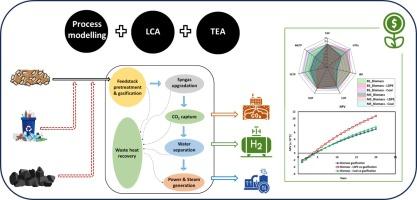生物质联合气化负碳制氢的工艺优化和环境经济评估
IF 9.9
1区 工程技术
Q1 ENERGY & FUELS
引用次数: 0
摘要
生物质废弃物资源丰富,但利用这些资源进行大规模绿色能源生产需要进行全面的战略评估。本研究开发了一种环境可持续且经济可行的气化工艺,用于从废弃生物质中产生纯氢气。为提高制氢效率,将斯维奇草与低密度聚乙烯(LDPE)和高灰分煤这两种辅助原料相结合。研究了生物质气化/协同气化的两种工艺配置:(1) 未添加碳捕集(CC)、余热回收(WHR)和厂内发电&;蒸汽发电(PSG)等可持续发展关键装置的基准方案,以及 (2) 添加了 CC、WHR 和 PSG 的综合方案。综合气化方案实现了超过 99% 的氢纯度和较高的碳捕获效率,使生物质、生物质-低密度聚乙烯和生物质-煤气化的碳排放量分别为-323.55、-465.84 和-68.28 千克二氧化碳当量。除此之外,综合方案在生态毒性、酸化、富营养化等大多数其他影响类别中也显示出负排放。生物质、生物质-低密度聚乙烯和生物质-煤气化综合方案的相应净现值分别为 6970 万美元、1.08 亿美元和 7640 万美元。结果表明,在综合气化方案中,生物质与低密度聚乙烯混合气化在环境和经济上最具可持续性,制氢量最高,环境排放最低,经济回报最高。研究还表明,工艺能源需求是环境排放和生产成本的主要驱动因素。这项研究为废物制氢技术提供了一个全面的评估框架,为大规模实施可持续制氢确定了关键的工艺热点和必要的政策措施。本文章由计算机程序翻译,如有差异,请以英文原文为准。

Process optimisation and enviro-economic assessment of carbon-negative hydrogen production from biomass co-gasification
Biomass wastes are abundantly available, yet leveraging these resources for large-scale green energy production requires a comprehensive and strategic evaluation. In this study, an environmentally sustainable and economically viable gasification process for generating pure hydrogen gas from waste biomass was developed. Switchgrass was combined with two co-feeds: low-density polyethylene (LDPE) and high ash coal to improve hydrogen production efficiency. Two process configurations for biomass gasification/co-gasification were investigated: (1) baseline scenario without addition of key units towards sustainability, including carbon-capture (CC), waste heat recovery (WHR) and in-plant power & steam generation (PSG), and (2) integrated scenario with the addition of CC, WHR and PSG. The integrated gasification scenario achieved over 99 % hydrogen purity and high carbon capture efficiency, leading to negative carbon emissions of –323.55, −465.84, and −68.28 kg CO2 eq. for biomass, biomass-LDPE and biomass-coal gasification, respectively. Besides this, integrated scenarios also displayed negative emissions in most of the other impact categories like ecotoxicity, acidification, eutrophication and many more. The corresponding net present value (NPV) for biomass, biomass-LDPE and biomass-coal gasification integrated scenario was $69.7 million, $108 million, and $76.4 million, respectively. The results indicate that biomass co-fed with LDPE in integrated gasification scenario represents the most environmentally and economically sustainable case with the highest hydrogen production, lowest environmental emissions and highest economic returns. It was also shown that process energy requirements were the key driver of environmental emissions and production costs. This research provides a comprehensive evaluation framework for waste-to-hydrogen technologies by identifying critical process hotspots and necessary policy measures for large-scale implementation of sustainable hydrogen.
求助全文
通过发布文献求助,成功后即可免费获取论文全文。
去求助
来源期刊

Energy Conversion and Management
工程技术-力学
CiteScore
19.00
自引率
11.50%
发文量
1304
审稿时长
17 days
期刊介绍:
The journal Energy Conversion and Management provides a forum for publishing original contributions and comprehensive technical review articles of interdisciplinary and original research on all important energy topics.
The topics considered include energy generation, utilization, conversion, storage, transmission, conservation, management and sustainability. These topics typically involve various types of energy such as mechanical, thermal, nuclear, chemical, electromagnetic, magnetic and electric. These energy types cover all known energy resources, including renewable resources (e.g., solar, bio, hydro, wind, geothermal and ocean energy), fossil fuels and nuclear resources.
 求助内容:
求助内容: 应助结果提醒方式:
应助结果提醒方式:


